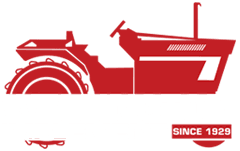Conceal
 The most efficient time to place fertilizer is during the planter pass, but many planter nitrogen attachments are bulky, messy, and high-maintenance. Conceal is a planter fertility attachment that is cleanly tucked into the row-unit and places nutrition in the soil 3 inches away from the seed.
The most efficient time to place fertilizer is during the planter pass, but many planter nitrogen attachments are bulky, messy, and high-maintenance. Conceal is a planter fertility attachment that is cleanly tucked into the row-unit and places nutrition in the soil 3 inches away from the seed.
Broadcast Applications Are Ineffecient
Broadcasting nitrogen before planting is an inefficient means of getting fertility to the plant. We only plant a row every few feet, so why spread fertilizer evenly across the entire field? A more efficient way to place fertilizer is to band the fertilizer in the row, just like we place the seeds. Banded nutrients can reduce the total amount of needed fertility by up to 30% while maintaining the same yield level. These banded nutrients should also be placed under the soil surface where they will stay in the soil, instead of being prone to volatilization when spread on top of the soil surface.
Plants Need Fertilizer While They Are Growing
Plants don't need fertilizer when the seed is still in the bag, they need the fertilizer while they are growing. This means it needs to be available for the roots to uptake in the most important times of the plant's life. In the case of nitrogen and corn, that first important time is from V4-V8 while the plant is determining the maximum size of ear that it can produce. Nitrogen needs to be readily available to the crown roots of the plant during this stage in order to maximize the yield that can be produced by that plant. A band of nitrogen placed under the soil surface will move down the soil profile with rains that occur after planting and will be a few inches deep, right where crown roots can get it when they need it.
Conceal Puts Nitrogen Where it Should Be
Conceal is a simple nutrient placement device that places fertilizer in a band, incorporated into the soil, where the plant will be able to get those nutrients during the critical ear set stage. Conceal can be utilized to put either a single or a dual band of nutrients down beside the row. Conceal is a combination of a gauge wheel which has a groove in it, and a knife running in the groove. The knife is guided by the gauge wheel so that placement is always the same distance from the seed. Since the knife is mounted to the front of the row unit, it does not interfere with the critical function that the gauge wheel plays: consistent and proper seeding depth. Conceal almost can't be seen on the row unit, tucked away inside the gauge wheel, where it does it's job without increased row unit length or bulk that typically comes with nitrogen attachments.
Consistent Placement Around Every Turn
Why is Conceal the most conistent way to place nitrogen with the planter? It's all in the design of the knife running beside the seed, in the groove of the gauge wheel. Since the knife is placing the fertilizer directly beside the seed and not in front of or behind the seed, the distance from the fertilizer to the seed is always consistent. Also, since the knife is running in conjunction with the gauge wheel, it will be placing the fertilizer at a consistent depth relative to the seed. Around curves, over uneven seedbeds, and on each row, the fertilizer is always where it needs to be relative to the seed.
Contact Us
-
824 US-42
Ashland, OH 44805
419-289-3610 -
6080 Norwalk Rd.
Medina, OH 44256
330-725-4951 -
625 South Main St.
Wellington, OH 44090
440-647-3725
© Copyright 2024 | All Rights Reserved. Site by EquipmentLocator.com

